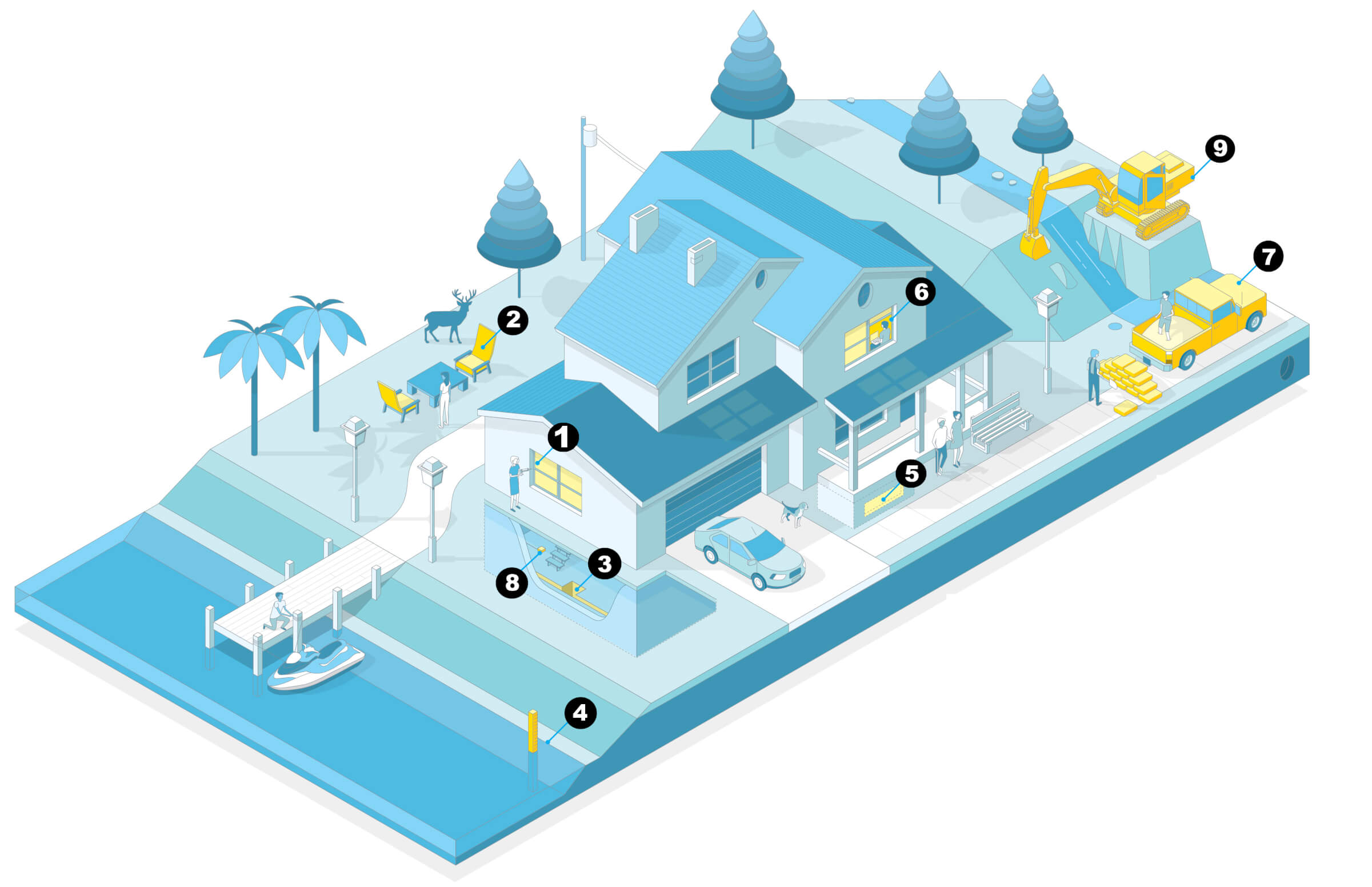Your Life
PROTECT YOUR HOME AGAINST RISING WATERS
More homes are at a higher risk of flooding. What you can do

As floodplains expand and serious storms become more frequent, U.S. homes are at ever-greater risk of water damage. The National Oceanic and Atmospheric Administration tracks major flooding incidents; last year, there were four flooding disasters with damage costs of at least $1 billion each. The total cost of those four disasters in 2023 was $9.3 billion. The cost to a homeowner from even minor flooding can be significant: A single inch of water can cause $25,000 worth of damage.
Though it’s impossible to flood-proof your home, insurance professionals say you can take steps to minimize the threat of water.

1. MIND THE GAP(S)
Use waterproof caulk and weather stripping to repair or close any gaps around doors and windows or the entry points for cable or electrical wires where water could enter your home, recommends Courtney Klosterman, spokesperson for Hippo Insurance. Caulking and weather stripping tend to deteriorate, so you’ll need to inspect these spots each year and repair as necessary.

2. ANCHOR OUTDOOR ITEMS
Even if water doesn’t get into your home, outdoor flooding can sweep away patio furniture, grills or fuel tanks, damaging them or other items in their way. Fasten them to the ground or another large structure to minimize movement, the Federal Emergency Management Agency recommends.

3. PUT IN A SUMP PUMP
If you have a basement, a sump pump—at about $1,500 to install—will redirect groundwater to outside the home if levels rise past a threshold. “That’s a good way to not only prevent flooding but also just basement seepage,” says ValuePenguin insurance analyst Divya Sangameshwar. Look for a pump with battery backup in case of a power outage.

4. FIND YOUR FLOOD LEVEL
Your local floodplain manager (contact your county government for guidance) can determine the base flood elevation (BFE) level for your home. This is how high water can be expected to rise in the worst flooding. You should move appliances or electrical items above that level, FEMA advises.

5. INSTALL FLOOD VENTS
These are openings built into a foundation, with doors that open only if flooding reaches a certain level. When they open, water flows into a crawl space, garage or cellar instead of the living space. After installation, it’s important to check them in dry times. “Make sure your flood vents are free from debris,” Sangameshwar says. “If they’re blocked, it defeats the purpose.” The National Flood Insurance Program (NFIP) requires flood vents in parts of homes below the BFE.

6. CONSIDER FLOOD INSURANCE
A standard homeowners policy won’t cover damage from flooding. For that, you need to purchase flood insurance through the NFIP. Such coverage is required in designated high-risk areas, but insurance professionals advise most homeowners to consider it. “It only takes a big rainstorm to bring a few inches of harmful water into your home or basement,” Klosterman says.

7. HAVE FLOOD BARRIERS READY
You can buy sandbags to place along doorways and other areas where water can seep into your home. But Steven Colorundo, director of claims with Plymouth Rock Home Assurance, says flood barriers are more effective. Filled with water, they can block the flow of additional water. They cost $4 to $15 per foot.

8. PURCHASE A SMART FLOOD DETECTOR
These alarms—which start at about $15—can detect even a small amount of moisture in a space and alert you, typically via a smartphone app. Place them in your basement or other potential trouble spots. Then, if an alarm goes off, you can take steps to minimize damage such as shutting off the electricity, moving items that might get damaged or setting up temporary flood barriers.

9. SEND WATER AWAY
Look at the slope of your yard and make sure that water runs downhill, away from your home. If not, you may need to hire a landscaper. Also, make sure that any gutter downspouts or sump pump discharge pipes let water out at least 10 feet away from the house, Sangameshwar says. That will keep water from pooling or seeping back in through the foundation.
Beth Braverman’s work has also appeared in Consumer Reports, Newsweek and CNNBusiness.com.
Preparing for an Evacuation
June is the start of the Atlantic hurricane season, but disasters can happen at any time—and not just in coastal communities. Everyone should be prepared for an emergency evacuation, says Jaclyn Rothenberg, director of public affairs for FEMA. She recommends packing a go bag ahead of time so you aren’t scrambling to find things at the last minute. Include these essential items:

Medications and medical supplies. Pack about three days’ worth of your prescriptions.

Food and drink. Granola bars and bottled water are good options.

Cellphone charger. Purchase a backup battery—and be sure to keep it charged—in case you can’t get to a power source.

Copies of your driver’s license and insurance cards. Pack these in a waterproof bag, so they don’t get damaged.

Other items to consider. Extra clothing, toiletries, a flashlight and enough cash to get you through a few days.

During a storm, listen to your local news stations (a battery-powered radio is good to have on hand) to learn whether neighborhoods in your ZIP code need to be evacuated. To find shelters near you, use your smartphone to check the American Red Cross website (redcross.org). The FEMA app (which you can download at Ready.gov) also provides disaster info. Remember that not all shelters are pet-friendly, so make arrangements ahead of time for your pet to stay with a loved one outside your immediate area. Even if your neighborhood is not evacuated, you should monitor news reports for shelter-in-place information. —Julie Goldenberg
FOLLOW THIS STORY
This is part of a larger AARP series. For an in-depth look at the toll of rising sea levels and more severe weather events, see the June/July issue of AARP The Magazine, visit aarp.org/washedaway.